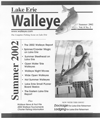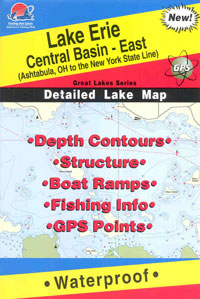Eastern Lake Erie Fishing
Report
By
Joe Fischer
The old adage that 10% of the fishermen catch 90% of the
fish could be used to assess the offshore Eastern Lake Erie summer walleye
fishery in the summer of 2003. The walleye fishermen that fished several
times a week could keep close tabs on the nomadic small schools of walleye
and consistently return to port with near limit walleye catches in late July
and August. Once again worm harnesses seem to work the best followed closely
by Ronesky and similar stick baits. Spoons tipped with worms also started
producing later in the summer. The veterans followed the old adage "run
silent run deep" using Downriggers, Dipsy Divers, Jet Planers, wire line,
braided line an other devices to attain the desired depth of the suspended
walleye schools. This year the majority of the walleye seemed to be west of
the Cattaraugus Creek, which is a return to the typical pattern of the
offshore walleye in the summer. Last year was unusual in that a lot of
walleye seemed to stay to the east of Cattaraugus Creek instead of gradually
moving west as the summer progressed.
fishermen that fished several
times a week could keep close tabs on the nomadic small schools of walleye
and consistently return to port with near limit walleye catches in late July
and August. Once again worm harnesses seem to work the best followed closely
by Ronesky and similar stick baits. Spoons tipped with worms also started
producing later in the summer. The veterans followed the old adage "run
silent run deep" using Downriggers, Dipsy Divers, Jet Planers, wire line,
braided line an other devices to attain the desired depth of the suspended
walleye schools. This year the majority of the walleye seemed to be west of
the Cattaraugus Creek, which is a return to the typical pattern of the
offshore walleye in the summer. Last year was unusual in that a lot of
walleye seemed to stay to the east of Cattaraugus Creek instead of gradually
moving west as the summer progressed.
Most fishermen had to really "pay their dues" as the
walleye season started very slowly. This was especially true during the
Southtowns Walleye Association's 19th annual walleye tournament as the water
was cold and the fish scattered. This tournament generally has approx.
entries and
many large fish are caught. This again was true in 2003 as it took a
12.36-pound walleye to win. Cash prizes were awarded for the top 200 fish
with low to cash exceeding 9 pounds. The walleye that wins this tournament
has gotten consistently bigger over the years, during the 1980's a lO-pound
walleye was uncommon with 5-10 being caught for the whole Southtowns
tournament and low to cash weighing between 7 and 8 pounds. Last year over
30 fish exceeded 10 pounds! The general trend in the eastern basin fishery
has fewer but larger walleyes. This year however a lot of 3-5 pound walleyes
have been showing up which is very encouraging for the future fishery.
Southtowns is a very conservation minded club in that they strongly advocate
catch and release if the fish is not intended for consumption and will not
even weigh in walleyes at their tournament that do not exceed 26".
The professional walleye fishermen (PWT) also had a
tournament in the middle of July at Dunkirk. These fishermen quickly showed
why they are pros as they caught hundreds of walleyes in their brief stay at
Dunkirk. They fished a little different then our local experts in that they
used a lot of lead core line to get their lures deep. The vast majority of
these fishermen had open bow aluminum boats between 18 and 24 feet equipped
with large outboard motors so they would waste very little time getting to
their selected fishing spots. These boats are great for smaller lakes but as
many of our Lake Erie veterans know, are marginal for offshore Lake Erie
fishing. The lack of weight and size almost caused a tragedy as one of these
boats capsized during a gale force windstorm with 8- 12-foot seas on the
second day of the tournament. Both participants were tossed into the sea but
as luck would have it another tournament boat happened to accidentally
discover them shortly afterwards. To accidentally discover anyone in the
water in 8-12 foot seas, I believe is extremely unusual to say the least!
One of the participants suffered minor injuries along with hypothermia and
was treated in Lakeshore hospital. Both boats did not hear the earlier
suspension of the tournament due to the high winds and rough water. The
capsized boat valued at approx. $80,000 went to the bottom and as of this
article has not been recovered. The local soup kitchens benefited from this
tournament as they received "unsavable" walleyes for their use. All of the
PWT tournaments advocate catch and release and the fish are
handled with due care but if the fish does not survive
they are normally donated to local charitable organizations who distribute
the fish to needy families.
Early reports seem to indicate that 2003 was an excellent
year for walleye spawning on the Eastern Shore of Lake Erie. Historically a
cold long winter followed by a rapid warm-up seems to produce the conditions
necessary for a good class year of walleye. I will have more on this once
the New York State Department of Environmental Conservation (NYSDEC)
completes their annual fall survey of the Eastern Lake Erie fishery.
Preliminary reports are that the western basin also might have a benchmark
year for walleye spawning.
The cooperative venture between the Erie County
Federation of sportsmen, the Erie County Fish Advisory board and the NYSDEC
is still being planned with the initial stocking of 50,000 walleye
fingerlings to take place in Buffalo River next spring. This landmark
program will run for approx. 5 years with an annual stocking of 50,000
fingerlings. It is hoped that the walleye eggs used for this project will
come from local waters such as the Cattaraugus Creek, Smokes Creek or from
the nearby open water shoals on Lake Erie. It is hoped that these walleye
fingerlings will imprint on the Buffalo River and return to spawn in the
future. This will stabilize the annual class year success of walleye on the
eastern basin, which at this time is problematic at best. The success of
spring open water spawning of walleye on Lake Erie is sometimes decimated by
the tenuous weather patterns in early spring.
The cold water fishery in the deeper waters off Dunkirk
and Barcelona Harbors was "hot" this summer with rainbows, lake trout and
the occasional Salmon leading the way. The New York State record for Lake
Trout was broken in August with a Lake trout that weighed in at over 41
pounds. It was not uncommon in August for offshore fishermen to return to
port with a "mixed bag" of fish which would sometimes include perch,
walleye, smallmouth bass and cold water species such as lake trout or
steelhead. The summer offshore steelhead fishing can be quite spectacular
due to the annual stocking programs of Pennsylvania and New York State.
Summer perch fishing was spotty for the fishermen and to
be successful the fishermen had to find the somewhat elusive schools of
perch. The fishing should pick up this fall when the perch school and feed
before the onset of winter. Last year the offshore fall perch fishing was
great with limit catches (50 fish) not unusual. I think this will again
occur during October and November. If the lake freezes I would expect to
have a repeat performance of last year when the ice fishing was excellent.
Last but not least the smallmouth bass fishing continued
to be world class in 2003. Mike Desforges of Ontario, Canada recently won a
KEY professional bass tournament with a weight of 53-02 pounds for 15
smallmouth bass. He collected $50,500 for his efforts. This fishery is
getting national attention and more and more tournaments are coming to the
area to check out this remarkable fishery. Fall musky fishing, which runs
through the end of November can produce trophy size muskies for the hardy
fishermen who want to brave the cold winds off Lake Erie in late fall.
Muskies in excess of 50 inches have been caught this summer and supposedly
the big ones bite in the fall! Almost all of the local musky fishermen
practice catch and release in an attempt to preserve and enhance this
fragile local fishery. I hope you had a good season, I certainly did.





 fishermen that fished several
times a week could keep close tabs on the nomadic small schools of walleye
and consistently return to port with near limit walleye catches in late July
and August. Once again worm harnesses seem to work the best followed closely
by Ronesky and similar stick baits. Spoons tipped with worms also started
producing later in the summer. The veterans followed the old adage "run
silent run deep" using Downriggers, Dipsy Divers, Jet Planers, wire line,
braided line an other devices to attain the desired depth of the suspended
walleye schools. This year the majority of the walleye seemed to be west of
the Cattaraugus Creek, which is a return to the typical pattern of the
offshore walleye in the summer. Last year was unusual in that a lot of
walleye seemed to stay to the east of Cattaraugus Creek instead of gradually
moving west as the summer progressed.
fishermen that fished several
times a week could keep close tabs on the nomadic small schools of walleye
and consistently return to port with near limit walleye catches in late July
and August. Once again worm harnesses seem to work the best followed closely
by Ronesky and similar stick baits. Spoons tipped with worms also started
producing later in the summer. The veterans followed the old adage "run
silent run deep" using Downriggers, Dipsy Divers, Jet Planers, wire line,
braided line an other devices to attain the desired depth of the suspended
walleye schools. This year the majority of the walleye seemed to be west of
the Cattaraugus Creek, which is a return to the typical pattern of the
offshore walleye in the summer. Last year was unusual in that a lot of
walleye seemed to stay to the east of Cattaraugus Creek instead of gradually
moving west as the summer progressed.